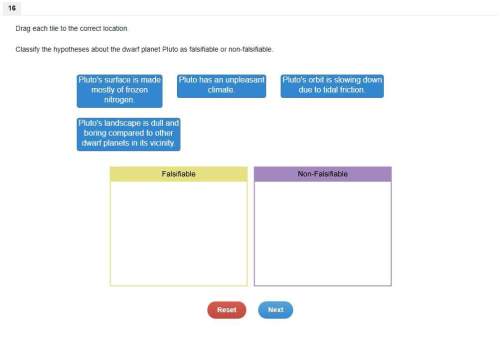
Physics, 24.01.2020 19:31 jadeochoa4466
You're driving down the highway late one night at 20 m/s when a deer steps onto the road 38 m in front of you. your reaction time before stepping on the brakes is 0.50 s , and the maximum deceleration of your car is 10 m/s2 .a. how much distance is between you and the deer when you come to a stop?
b. what is the maximum speed you could have and still not hit the deer?

Answers: 2
Another question on Physics

Physics, 21.06.2019 22:40
Ablock of mass m = 2.5 kg is attached to a spring with spring constant k = 710 n/m. it is initially at rest on an inclined plane that is at an angle of θ = 23° with respect to the horizontal, and the coefficient of kinetic friction between the block and the plane is μk = 0.19. in the initial position, where the spring is compressed by a distance of d = 0.16 m, the mass is at its lowest position and the spring is compressed the maximum amount. take the initial gravitational energy of the block as zero. a) what is the block's initial mechanical energy? b) if the spring pushes the block up the incline, what distance, l, in meters will the block travel before coming to rest? the spring remains attached to both the block and the fixed wall throughout its motion.
Answers: 3

Physics, 21.06.2019 23:00
Follow these directions and answer the questions. 1. set up the ripple tank as in previous investigations. 2. bend the rubber tube to form a "concave mirror" and place in the ripple tank. the water level must be below the top of the hose. 3. generate a few straight pulses with the dowel and observe the reflected waves. do the waves focus (come together) upon reflection? can you locate the place where the waves meet? 4. touch the water surface where the waves converged. what happens to the reflected wave? 5. move your finger twice that distance from the hose (2f = c of c, center of the curvature) and touch the water again. does the image (the reflected wave) appear in the same location (c of c)? you may have to experiment before you find the exact location. sometimes it is hard to visualize with the ripple tank because the waves move so quickly. likewise, it is impossible to "see" light waves because they have such small wavelengths and move at the speed of light. however, both are examples of transverse waves and behave in the same way when a parallel wave fronts hit a curved surface.
Answers: 1

Physics, 22.06.2019 01:00
Need asap ! what is the relationship between atmospheric pressure and the density of gas particles in an area of increasing pressure? (2 points) as air pressure in an area increases, the density of the gas particles in that area decreases. as air pressure in an area increases, the density of the gas particles in that area increases. as air pressure in an area increases, the density of the gas particles in that area remains constant. as air pressure in an area increases, the density of the gas particles in that area increases and decreases in an alternating pattern. 3. which of the following correctly describes a way in which earth's atmosphere interacts with the geosphere? (2 points) it contains gases that living organisms breathe. it contains gases that trap incoming solar radiation. it provides a medium for cycles that provide nutrients to living organisms. it provides a medium for water to move between earth's surface and the air. 4. which of the following is considered a drawback to using wind energy as a source of power? (2 points) wind energy is nonrenewable. wind energy produces large amounts of air pollution. 5. a meteorologist predicts that the weather in a region will soon change from clear skies to probable thunderstorms. prior to making this prediction, what did the meteorologist most likely observe on a barometer? (2 points) the barometer fell slightly. the barometer fell substantially. the barometer rose slightly. the barometer rose substantially. 6. which of the following do meteorologists not typically use weather balloons to record? (2 points) atmospheric pressure cloud types humidity temperature 7. during which step in the can crush lab did water vapor force air from the can? (2 points) the can was filled nearly to the top with water. the can was placed on the hot stove top burner for several minutes. the can was removed from the hot stove top burner. the can was placed upside-down in the water-filled pan.
Answers: 2

Physics, 22.06.2019 05:50
Give your knowledge of these things in your paper, you will compare and contrast analog and digital signals to determine which is more reliable for encoding and transmitting information. you’ll compare these features: signal shape numerical values for signal measurements amount of data that can be transmitted energy requirements privacy and security (ability of the signal to be encoded in a secret code) clarity of signal in the space provided, write down what you already know about any of these features. if you’re not sure, write down questions you might have about the features.
Answers: 3
You know the right answer?
You're driving down the highway late one night at 20 m/s when a deer steps onto the road 38 m in fro...
Questions


Mathematics, 04.08.2019 14:00




Mathematics, 04.08.2019 14:00

Mathematics, 04.08.2019 14:00

History, 04.08.2019 14:00

French, 04.08.2019 14:00

History, 04.08.2019 14:00




Biology, 04.08.2019 14:00

History, 04.08.2019 14:00


Chemistry, 04.08.2019 14:00








